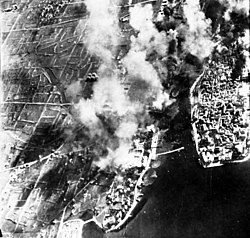Bombing of Zara in World War II
| Bombing of Zadar | |||||||
|---|---|---|---|---|---|---|---|
| Part of Strategic bombing during World War II | |||||||
 Zadar during the bombing raid |
|||||||
|
|||||||
| Belligerents | |||||||
|
|
|
||||||
| Casualties and losses | |||||||
| 0 | 1,000-4,000 deaths | ||||||
The bombing of Zadar (Italian: Zara) during the Second World War by the Allies lasted from November 1943 to October 1944. Although other large cities in Italy were also bombed, the bombing of Zadar stands out because of the number of attacks and the number of fatalities. Reports vary greatly; the Allies documented 30 bombing raids, while contemporary Italian accounts claim 54. Fatalities recorded range from under 1,000, up to as many as 4,000 of the city's 20,000 inhabitants.
Over the course of the bombing, 60% of the city's buildings were destroyed. Zadar has been called the "Dresden of the Adriatic" because of perceived similarities to the Allied bombing that city. In both cases, Allied bombs devastated a city rich in artistic and historical treasures but with no apparent industrial or military targets.
It is the most significant historical event in Zadar after the Siege of Zadar in 1202 by forces of the Fourth Crusade.
Zadar (known in Italian as Zara) became part of the Kingdom of Italy as a result of the Treaty of Rapallo of 1920, which settled the status of former Austro-Hungarian territories. It had a large Italian majority and was an Italian enclave in Dalmatia. From the 1920s on, many more Croats were pressured to leave the city while their place was being taken by ethnic Italians resettling there from within Yugoslavian Dalmatia—such as the famous fashion stylist Ottavio Missoni, who moved with his family from Dubrovnik. The 1910 census in Austria-Hungary placed the Italians at 69.3% of the population, which consistently rose in the decades that followed. Public functionaries, teachers, and policemen were transferred from the mainland.
...
Wikipedia
